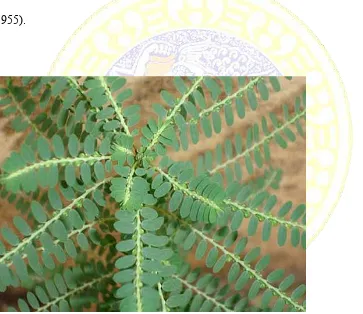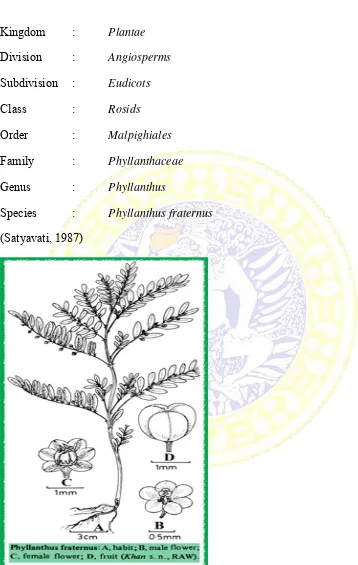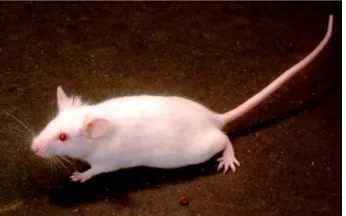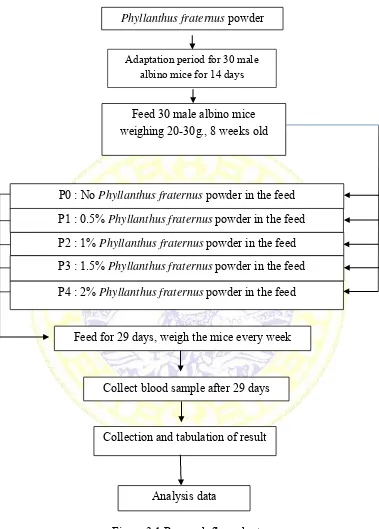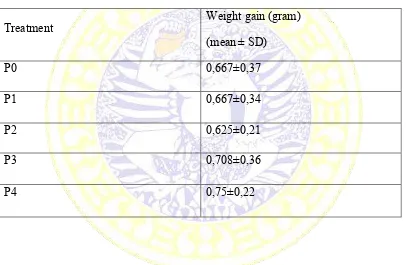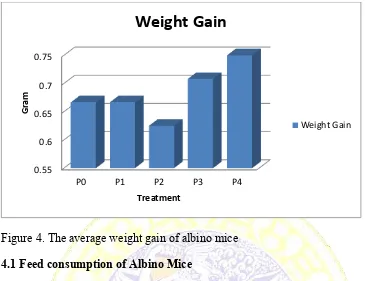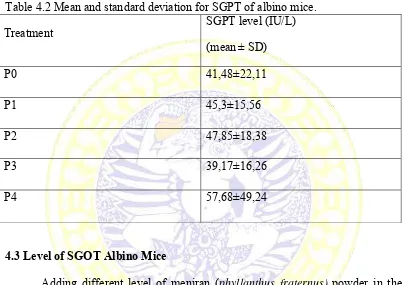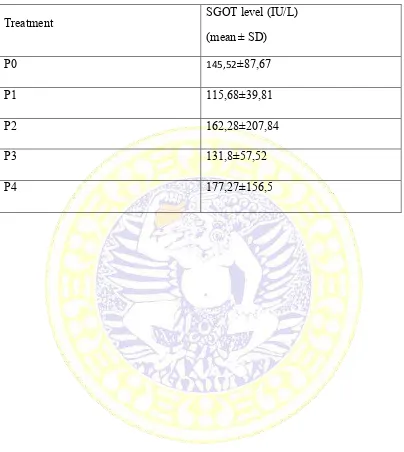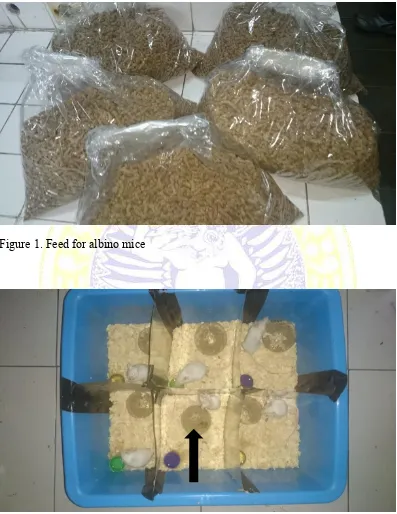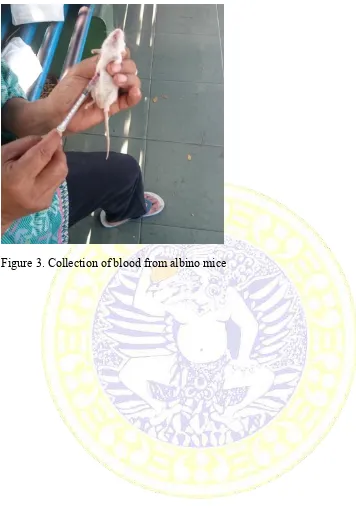ENDORSEMENT FORM
THE POTENTIAL OF MENIRAN (
Phyllanthus
Fraternus)
POWDER SUPPLEMENTATION WITH
DIFFERENT CONCENTRATIONS IN ALBINO MICE
DIET ON THEIR GROWTH PERFORMANCE AND
LIVER HEALTH
Thesis
Submitted in partial fulfillment of the requirement for degree bachelor of Veterinary Medicine at
Faculty of Veterinary Medicine, Universitas Airlangga Surabaya By :
Pavithran Puvipalachandran 061111252
Approval of Supervising comitte
DECLARATION
Hereby, I declare that in this thesis entitled :
THE POTENTIAL OF MENIRAN (
Phyllanthus
Fraternus)
POWDER SUPPLEMENTATION WITH
DIFFERENT CONCENTRATIONS IN ALBINO MICE
DIET ON THEIR GROWTH PERFORMANCE AND
LIVER HEALTH
Has been assessed in Result Seminar Date: 19th August 2015
RESULT SEMINAR ASSESSEMENT COMMITTEE Head : Dr. Mirni Lamid, drh., M.P.
Has been examined Date: 21st August 2015
THESIS DEFENSE ASSESSMENT COMMITTEE Head : Dr. Mirni Lamid, drh., M.P.
THE POTENTIAL OF MENIRAN (PhyllanthusFraternus) POWDER
SUPPLEMENTATION WITH DIFFERENT CONCENTRATIONS IN ALBINO MICE DIET ON THEIR GROWTH PERFORMANCE AND
LIVER HEALTH Pavithran Puvipalachandran
ABSTRACT
The aim of this research is to know about the potential of meniran plant (Phyllanthus Fraternus) as a supplement in albino mice feed and to monitor the growth rate. Thirty male albino mice aged 8 weeks were feed with different concentration of meniran and are grouped into five treatments and six replications. P0 had no meniran powder; P1, P2, P3 and P4 were treated with 0.5%, 1%, 1.5% and 2% meniran powder respectively for 29 days. The weight of the mice was measured every week and the blood sample was collected to test for SGPT and SGOT. Data was analysed with Analysis of Variance (Anova). The result showed that meniran has no effect on the weight gain of albino mice. It also proves that meniran is not significantly different for the SGPT and SGOT and the test result was in normal range value.
ACKNOWLEDGEMENTS
First I would like to Praise and thank Allah SWT without Whose permission and guidance this thesis entitled The Potential Of Meniran (Phyllanthus Fraternus) Powder Supplementation With Different Concentrations In Albino Mice Diet On Their Growth Performance and Liver Health would not be finished.
On this occasion the author would like to give thanks to:
Dean of the Faculty of Veterinary Medicine, University of Airlangga, Prof.Hj.Romziah Sidik, drh., Ph.D. for the opportunity to study in the Faculty of Veterinary Medicine, University of Airlangga.
The Supervising committee Prof.Hj.Romziah Sidik, drh., Ph.D. and HJ.Retno Sri Wahjuni, drh.M.S. for going through all the trouble and the time taken for consultation sessions for this thesis.
The Examiner committee, Dr. Mirni Lamid, drh., M.P., Dr. Dady Soegianto Nazar., drh., M.Sc., and Rudy Sukamto.Setiabudi, drh., M.Sc. for all advices and guidances.
My beloved father Puvipalachandran also mother Soowady and my siblings have been patient, support and always pray for me. I am so grateful.
My friends in small class 2011 thanks for 4 years togetherness and always cheer me up and give some motivation to finish this Thesis.
The author acknowledges that this writing is still lacking and has not perfect yet. Therefore, the author expects critics and recommendations that will help in the improvement of this thesis. Hopefully this research will be useful for the advancement of science and may give a contribution to the veterinary medicine field and all the people who need it.
Surabaya, August 2015
FIGURES
Figure Page
2.1 Meniran Plant (Phyllanthus Fraternus) ... 7
2.2 Phyllanthus Fraternus ... 8
2.3 Mus musculus ... 19
ABBREVIATIONS AND SYMBOLIC MEANING Anova : Analysis of Variance
˚C : Degrees Celsius µm : Micrometer ml : Mililiter mm : Millimeter mg : Milligram
n : Number of replication
SPSS : Statistical Product and Service Solution t : Treatment
SGPT : Serum Glutamic Pyruvic Transaminase SGOT : Serum Glutamic Oxaloacetic Transaminase AST : Aspartate Transaminase
ALT : Alanine Transaminase
CRD : Complete Randomized Design
OEDC : Organization for Economic and Development
CHAPTER 1 INTRODUCTION
1.1 Background
Plants are very important commercial source of chemical compounds including primary and secondary metabolites. Higher plants have been used as sources of drugs to combat diseases for several thousand years. However, there
has been renewed scientific interest in plant extracts and their constituents for
health care during the past two decades. Our remote ancestors may have observed
wild animals to discover plants species that could be used for food, others that should be avoided, and perhaps some that cure sickness (Monika Christina, 2014).
This shift from synthetic chemical agents to plant-based products is
primarily due to the frequent untoward effects seen with synthetic chemical
agents. In addition, under different stress conditions the body requires additional
vitamins and/or minerals, which need to be supplemented in the diet (Halliwell,
Gutteridge, 1992). Supplementation not only helps to overcome nutrient depletion
but also decreases the risk for chronic diseases, with the added advantage of
considerably reduced health costs (Meydani et al., 1998).
Plants have always been an exemplary source of drugs. Many of the
modern drugs that are currently available have also been derived directly or
indirectly from herbal sources. Herbal medicines have been proved to be highly
effective, economical and safe alternative tools for the treatment of various human
diseases (Kirtikar and Basu, 1975).
Several medicinal plants have been used as dietary adjunct and in the
population living in developing countries relies essentially on plants for primary
health care so herbal medicine associated pharmacology and pharmaceutical
products are required to update frequently (McKay, 2007).
Phyllanthus fraternus is an ancient Indian traditional medicine used for treatment of several human diseases including hepatic and renal disorders. It belongs to the Euphorbiaceous family in plant division and an annual herb, distributed in India, Pakistan, South Arabia, Africa, Indonesia, and Malaysia (Abedin et al., 2001). It is also widely used as a folklore remedy for the treatment of various diseases of liver by traditional healers and tribal people (Kirtikar and Basu, 1975).
Toxicity is the fundamental science of poisons. The organization for Economic and Development (OEDC) mention acute toxicity as the advance effect occurring within a short time of oral administration of a simple dose of a substance or a multiple doses given within 24 hours (OECD Guideline, 1999) Phychochemical interaction of poisons lead to injury or death of living tissue. Toxicology is like science and art like medicine. It includes observation data gathering and data utilization to predict outcome of exposure in human and animals. The ancient humans categorized some plants as harmful and some as safe (Godhawani, 1987).
1.2 Identification of Problem
1. Whether by increasing the meniran plant Phyllanthus fraternus ratio in the feed of albino mice will affect the body weight gain of the animal?
2. Whether by giving higher concentration of Meniran plant Phyllanthus
fraternus ratio in the feed of albino mice will affect the condition of the Serum Glutamic Oxaloacetic Transaminase (SGOT) and Serum Glutamic
Pyruvic Transaminase (SGPT)?
1.3 Theoretical Base
The plant extracts are used for treating many types of biliary and urinary
conditions like gall bladder, kidney stones, and bacterial infections such as
cystitis, prostatitis, viral infections, hepatitis, flu, tuberculosis, liver diseases,
anaemia, venereal diseases, and urinary tract infections (Chanda, 2011). The
antimicrobial property of Phyllanthus fraternus has been reported by (Chanda,
2011). The aqueous extract of the plant shows antioxidant property (Sailaja, 2006)
and has protective effect against bromobenzene induced mitochondrial
dysfunction. Also the extract can reduce toxicity of drugs such as cisplatin and
cyclophosphamide and therefore can be used to raise the therapeutic potential of
anticancer drugs (Koffuor, 2011).
Liver function tests are one of the blood tests that are most commonly
performed to assess the function of the liver or injury caused to the liver. Liver
damage is detected initially by performing a simple blood test that determines the
level of various liver enzymes present in the blood. The most widely used liver
measured are the aminotransferases. The two aminotransferases that are checked
are the alanine aminotransferase (ALT or SGPT) and aspartate aminotransferase
(AST or SGOT). These liver enzymes form a major constituent of the liver cells.
They are present in lesser concentration in the muscle cells. When the liver cells
get damaged or injured, these enzymes seep into the blood stream, raising their
blood levels. Hence raised blood levels of SGOT and SGPT signifies liver disease
or injury (Lee, 2009).
The aminotransferases catalyse the chemical reactions involving the amino
acids, where an amino group is transferred from the donor amino acid to the
recipient molecule. Aminotransferases are also referred to as transaminases.
Another name for AST is Serum Glutamic Oxaloacetic Transaminase (SGOT).
Similarly another name for ALT is Serum Glutamic Pyruvic Transaminase
(SGPT). Hence, AST is also referred to as SGOT and ALT is also referred to as
SGPT.
Serum Glutamic Oxaloacetic Transaminase is normally present in a
number of tissues such as heart, liver, muscle, brain and kidney. It is released into
the blood stream whenever any of these tissues gets damaged. For instance, blood
AST level is increased in conditions of muscle injury and heart attacks. Hence, it
is not highly specific liver tissue damage indicator as it can be elevated in
conditions other than liver damage.
By contrast, SGPT is normally present in large concentrations in the liver.
Hence, due to liver damage its level in the blood rises, thereby, serving as a
1.4 Aim of Research
1. To monitor the growth rate of the albino mice after feeding Phyllanthus
fraternus as a supplement.
2. The purpose of this research is to know the effect of Phyllanthus fraternus as a supplement feed for albino mice.
1.5 Outcome of Research
The outcome of this research is to give information to the feed manufacture that meniran plant Phyllanthus Fraternus can be used as a supplement for rodent feed which have health benefits. It is also expected to give choice for the consumers who are buying the feed for their rodent.
1.6 Hypothesis
1. By giving higher concentration of meniran plant Phyllanthus fraternus ratio in the feed of albino mice the body weight gain of the animal will
be expected to increase.
CHAPTER 2 LITERATURE REVIEW
2.1 Review of Meniran Plant (Phyllanthus Fraternus)
2.1.1 Origin and Geographic Distribution
Phyllanthus fraternus is a pan tropical weed and probably originates from Indonesia and western India. In tropical Africa it occurs from Cape Verde east to Somalia and south to South Africa, except in the most humid regions (Gray Herb, 1955).
Figure 2.1 Meniran Plant (Phyllanthus Fraternus) (Oudhia, 2008)
2.1.2 Taxonomy
Kingdom : Plantae Division : Angiosperms Subdivision : Eudicots Class : Rosids
Order : Malpighiales Family : Phyllanthaceae Genus : Phyllanthus
Species : Phyllanthus fraternus (Satyavati, 1987)
2.1.3 Description of Phyllanthus fraternus
Monoecious, annual herb up to 45(–60) cm tall, glabrous to short-hairy; vertical shoots angular, pale brown, lateral shoots up to 10 cm long. Leaves alternate, distichous, almost sessile; stipules. 1 mm long, linear-lanceolate, whitish; blade elliptical-oblong, 5–13 mm × 2–5 mm, base cuneate to rounded, apex obtuse or rounded, glabrous, with 4–7 pairs of lateral veins. Flowers in the axils of leaves, male flowers (1–)3 per axil at the base of branches, other leaf axils usually with 1 female flower. Flowers unisexual; pedicel. 0.5 mm long; male flowers with 6 perianth lobes, obovate-orbicular. 0.5 mm long, in 2 whorls, translucent, disk glands 6, free, flattened, stamens 3, filaments fused; female flowers with 6 perianth lobes. 1 mm long, the outer ones oblong-lanceolate, the inner ones oblong to oblanceolate, white, disk. 0.5 mm across, fringed, ovary superio. 0.5 mm in diameter, 3-celled, styles 3. 0.5 mm long. Fruit a 3-lobed nearly globose capsule c. 1 mm × 1.5 mm, smooth, yellowish, 6-seeded. Seeds 1 mm long, segmented, yellowish brown, one side with dark brown tubercles, with concentric ridges on the other side. (Oudhia, 2008)
Chromosome number 2n = 24 (Oudhia, 2008).
2.1.4 Benefit of Phyllanthus fraternus
Réunion the plant is also used against gonorrhoea, dropsy and diarrhoea. (Oudhia, 2008).
In India Phyllanthus fraternus, in a mixture with other Phyllanthus spp., is sold in a herbal medicine called „Bhumyamlaki‟, which is widely used against jaundice and is considered acrid, carminative, cooling and useful in the treatment of thirst, bronchitis, asthma, leprosy, anaemia, venereal diseases, problems of the genito-urinary tract, anuria, biliousness and hiccups. The fruits are used in the treatment of ulcers, wounds, sores, scabies, ringworm and other skin problems. Fresh roots are taken against jaundice, and crushed with milk as a galactagogue. A decoction of roots and leaves is used to treat malaria. The plant sap is applied to treat bruises, sores and ulcers, and mixed with oil against ophthalmia and conjunctivitis. Powdered roots and leaves are made into a poultice with rice-water to treat oedema and ulcers. (Oudhia, 2008).
Phyllanthus fraternus is browsed by all livestock. In East Africa, India and Indonesia a black dye is obtained from the stem and leaves, which is used to dye cotton and can also be used as an ink. (Oudhia, 2008).
2.1.5 Properties of Phyllanthus fraternus
tetraterpenoid phyllanthusone, and waxes (octacosane, tetracosyl alcohol, tricosyl alcohol). Some of the alcohols are also present as esters, e.g. phyllanterpenyl ester and pentacosanyl ester. An alcohol extract of the root contained the seco-sterols phyllanthosterol, phyllanthosecosteryl ester, phyllanthostigmasterol and fraternusterol. The seed oil contains ricinoleic acid, linoleic acid and linolenic acid. (Oudhia, 2008).
The two isolated alkamides possessed moderate antiplasmodial activity in vitro. An aqueous extract of the plant showed protection against the effect of chronic alcohol consumption on the liver in rabbits. The decrease in cytochrome content of the cells was partly undone by the extract. The extract showed a beneficial effect on mitochondria of the cells. An aqueous ethanol extract of the dried plant showed protection of the liver against the effects of arsenic trioxide in chickens. (Oudhia, 2008)
2.2 Review Of Liver
2.2.1 View of the Liver
Liver is a large, meaty organ that sits on the right side of the belly. The liver is reddish-brown in colour and feels rubbery to the touch. Normally you can't feel the liver, because it's protected by the rib cage. (Zakim, 2002).
The liver and these organs work together to digest, absorb, and process food. (Zakim, 2002).
The liver's main job is to filter the blood coming from the digestive tract, before passing it to the rest of the body. The liver also detoxifies chemicals and metabolizes drugs. As it does so, the liver secretes bile that ends up back in the intestines. The liver also makes proteins important for blood clotting and other through the bile ducts to be stored in the gallbladder. When food containing fats reaches the duodenum, the cells of the duodenum release the hormone cholecystokinin to stimulate the gallbladder to release bile. Bile travels through the bile ducts and is released into the duodenum where it emulsifies large masses of fat. The emulsification of fats by bile turns the large clumps of fat into smaller pieces that have more surface area and are therefore easier for the body to digest.
an energy source for the body. The iron-containing heme group cannot be recycled by the body and is converted into the pigment bilirubin and added to bile to be excreted from the body. Bilirubin gives bile its distinctive greenish colour. Intestinal bacteria further convert bilirubin into the brown pigment stercobilin, which gives faces their brown colour. (Zakim, 2002).
2. Metabolism
The hepatocytes of the liver are tasked with many of the important metabolic jobs that support the cells of the body. Because all of the blood leaving the digestive system passes through the hepatic portal vein, the liver is responsible for metabolizing carbohydrate, lipids, and proteins into biologically useful materials.
Our digestive system breaks down carbohydrates into the monosaccharide glucose, which cells use as a primary energy source. Blood entering the liver through the hepatic portal vein is extremely rich in glucose from digested food. Hepatocytes absorb much of this glucose and store it as the macromolecule glycogen, a branched polysaccharide that allows the hepatocytes to pack away large amounts of glucose and quickly release glucose between meals. The absorption and release of glucose by the hepatocytes helps to maintain homeostasis and protects the rest of the body from dangerous spikes and drops in the blood glucose level.
process of gluconeogenesis. Hepatocytes can also produce lipids like cholesterol, phospholipids, and lipoproteins that are used by other cells throughout the body. Much of the cholesterol produced by hepatocytes gets excreted from the body as a component of bile. (Zakim, 2002).
Dietary proteins are broken down into their component amino acids by the digestive system before being passed on to the hepatic portal vein. Amino acids entering the liver require metabolic processing before they can be used as an energy source. Hepatocytes first remove the amine groups of the amino acids and convert them into ammonia and eventually urea. Urea is less toxic than ammonia and can be excreted in urine as a waste product of digestion. The remaining parts of the amino acids can be broken down into ATP or converted into new glucose molecules through the process of gluconeogenesis. (Zakim, 2002).
3. Detoxification
As blood from the digestive organs passes through the hepatic portal circulation, the hepatocytes of the liver monitor the contents of the blood and remove many potentially toxic substances before they can reach the rest of the body. Enzymes in hepatocytes metabolize many of these toxins such as alcohol and drugs into their inactive metabolites. And in order to keep hormone levels within homeostatic limits, the liver also metabolizes and removes from circulation hormones produced by the body‟s own glands. (Zakim, 2002).
4. Storage
is transported into hepatocytes under the influence of the hormone insulin and stored as the polysaccharide glycogen. Hepatocytes also absorb and store fatty acids from digested triglycerides. The storage of these nutrients allows the liver to maintain the homeostasis of blood glucose. Our liver also stores vitamins and minerals - such as vitamins A, D, E, K, and B12, and the minerals iron and copper - in order to provide a constant supply of these essential substances to the tissues of the body. (Zakim, 2002).
5. Production
The liver is responsible for the production of several vital protein components of blood plasma: prothrombin, fibrinogen, and albumins. Prothrombin and fibrinogen proteins are coagulation factors involved in the formation of blood clots. Albumins are proteins that maintain the isotonic environment of the blood so that cells of the body do not gain or lose water in the presence of body fluids. (Zakim, 2002).
6. Immunity
system and the liver allows Kupffer cells to clean large volumes of blood very quickly (Zakim, 2002).
2.2.3 Liver Function Tests
As the liver performs its various functions, it makes chemicals that pass into the bloodstream and bile. Various liver disorders alter the blood level of these chemicals. Some of these chemicals can be measured in a blood sample. Some tests that are commonly done on a blood sample are called liver function tests (LFTs). (Johnston, 1999) These usually measure the following:
Alanine transaminase (ALT or SGPT). This is an enzyme that helps to process proteins. (An enzyme is a protein that helps to speed up chemical reactions. Various enzymes occur in the cells in the body.) Large amounts of ALT or SGPT occur in liver cells. When the liver is injured or inflamed (as in hepatitis), the blood level of ALT or SGPT usually rises. (Johnston, 1999)
Aspartate aminotransferase (AST or SGOT). This is another enzyme usually found inside liver cells. When a blood test detects high levels of this enzyme in the blood it usually means the liver is injured in some way. However AST or SGOT can also be released if heart or skeletal muscle is damaged. For this reason ALT or SGPT is usually considered to be more specifically related to liver problems. (Johnston, 1999)
Albumin. This is the main protein made by the liver, and it circulates in the bloodstream. The ability to make albumin (and other proteins) is affected in some types of liver disorder. A low level of blood albumin occurs in some liver disorders. (Johnston, 1999)
Total protein. This measures albumin and all other proteins in blood.
Bilirubin. This chemical gives bile its yellow/green colour. A high level of bilirubin in your blood will make you jaundiced ('yellow'). Bilirubin is made from haemoglobin. Haemoglobin is a chemical in red blood cells that is released when the red blood cells break down. Liver cells take in bilirubin and attach sugar molecules to it. This is then called 'conjugated' bilirubin which is passed into the bile ducts. (Johnston, 1999)
A raised blood level of 'conjugated' bilirubin occurs in various liver and bile duct conditions. It is particularly high if the flow of bile is blocked. For example, by a gallstone stuck in the common bile duct, or by a tumour in the pancreas. It can also be raised with hepatitis, liver injury, or long-term alcohol abuse. (Johnston, 1999)
A raised level of 'unconjugated' bilirubin occurs when there is excessive breakdown of red blood cells - for example, in haemolytic anaemia. (Johnston, 1999)
2.3 Experimental Animal 2.3.1 Classification
Mice or white mouse are frequently used as a laboratory animals for research (Figure 6). This laboratory mice strains have many good inbread (DDY, Balb / c, DBA, and B6) and outbred like webster. The classification of laboratory mice are as follows:
births per lot, high variations of its properties and easy to handle (Moriwaki et al. 1994).
Figure 2.3 : Mus musculus (source : Garima And Goyal., 2007).
CHAPTER 3 MATERIAL AND METHODS
3.1 Research Location and Timeline
The research of meniran (phyllanthus fraternus) powder supplementation on different concentrations in albino mice diet on their growth performance and health was performed at Feed and Nutrition Laboratory, Department Animal Husbandry and Pathology Clinic of Veterinary Medicine Airlangga University Surabaya, Indonesia. The duration of the experiment was one month.
3.2. Research Materials
3.2.1 Plant Material
The plant material which was used for this research is Phyllanthus
Fraternus was obtained from Bilitro Surabaya (Balai Penelitian Tanaman Rempah dan Obat) Surabaya, East Java, Indonesia. The plants were chosen for its own criteria, green leaves with seeds.
3.2.2 Laboratory Animal
Animal used for this research are 30 male albino mice (mus musculus
3.2.3 Research equipment’s
The equipment‟s for this research are laboratory equipment‟s for some purposes of each different research procedures: scalpel, petri disk, plastic bowl, pinset, bucket, pyrex beaker glass 500 ml, pyrex erlenmeyer 250 ml, thermometer, glass rod, duster, water bath, gas stove, incubator, pellet machine, grinding machine, digital weight measurer, and plastic for storing the feed, plastic cage with height 13 cm and floor width 372 cm² with husk litter, water supplier, and feeding bowl.
3.3 Research Methods 3.3.1 Research Variables 3.3.1.1 Independent Variable
Independent variable used on this research was the dose of Phyllanthus fraternus administered to each group of albino mice.
3.3.1.2 Dependent Variable
Dependent variable in this research is the result of SGOT, SGPT and the weight gain of the albino mice.
3.3.1.3 Control Variable
3.3.2 Sample Size of Albino Mice
The sample size of mice was determined according to Kusriningrum (2008) formulation for Complete Randomized Design. The calculation performed as follows:
t (n-1) ≥ 15 5(n-1) ≥ 15 5n-5 ≥ 15
n ≥ 4
Annotation: t = group of treatment; n = minimum replication in a single group of research treatment
3.3.3 Research Design
This experiment is designed as a complete randomized design (CRD) with 5 levels of Phyllanthus fraternus powder and 5 replicates. Each replication will have about 6 albino mice per cage. The treatments are:
Phyllanthus fraternus powder levels:
P0: No Phyllanthus fraternus powder in the feed P1: 0.5% Phyllanthus fraternus powder in the feed P2:1% Phyllanthus fraternus powder in the feed P3: 1.5% Phyllanthus fraternus powder in the feed P4: 2% Phyllanthus fraternus powder in the feed
3.4 Research Procedure
3.4.1 Phyllanthus fraternus powder Preparation and Crude Protein analysis
Fresh Phyllanthus fraternus plant has to be washed and dried. After dried mashed up with a grinder into powder, then the powder is used as materials for calculating the crude protein.
Weigh the sample weighing 0.5 grams on paper that has been in the know weighed, and then insert the sample into the flask Kjeldhal. Add to it as much as 1/4 tablet Kjeldhal and then 10ml of concentrated H2SO4. Heat the flask using
Kjeldhal heater in an acid cupboard. The heating proses is stop when there is no smoke and the colour changes to yellowish green (approx. ±1.5 hours). Leave it for few seconds for the flask to cool down. The solutions is then poured into a volumetric flask and dilute it with aquadest until the volume reaches 250ml. Pour the solution into an Erlenmeyer 300ml and shake it until homogeneous. Prepare Erlenmeyer 100ml which is filled with 10ml of boric acid solution and 2 drops of methyl red indicator with 3 drops Brom cresol green for accommodate the evaporation. Ready the Marcam Steel. Distillation flask 2000ml is filled with 1000ml of water and few grains of heated rocks put a 100ml Erlenmeyer which is prepared on the frame of Marcam Steel. Take 10ml of the solution just now and pour through a funnel into Marcam Steel. Add about 5ml of NaOH 40%. Heat the distillation flask and contain the steam that comes out of Marcam Steel into an erlenmeyer. The heating is carried for about 5 minutes after the water boils or the volume of the Erlenmeyer reaches 50ml. The solution that has been mixed with steam and H2SO4 0.01 N is titrated until the light blue changes into green.
Annotation: N: Normality H2SO4 = 0.01 N
P: Dilution = 250/10 =25 (Herman et al., 2012).
3.4.2 Manufacture of pellets for albino mice
A ration formula was prepared for making the pellets. Microsoft Excel was used for calculating the ratio formula that is needed for the preparation. The raw materials feed was chosen for making the pellets. The nutrient content of the calculation result is according to the Standard National Indonesia (SNI).
3.4.3 Treatment period
3.5 Data Analysis
The animals were weighed five times at the beginning (first day), the second time (8th day), the third time (15th day), the fourth time (22st day) and the end of feeding trial period (29th day) to calculate average weight gain. Blood samples were
3.6 Research Flow Chart
Figure 3.1 Research flow chart. Phyllanthus fraternus powder
Feed 30 male albino mice weighing 20-30g., 8 weeks old
P0 : No Phyllanthus fraternus powder in the feed P1 : 0.5% Phyllanthus fraternus powder in the feed
P2 : 1% Phyllanthus fraternus powder in the feed P3 : 1.5% Phyllanthus fraternus powder in the feed
P4 : 2% Phyllanthus fraternus powder in the feed
Feed for 29 days, weigh the mice every week
Analysis data
Collect blood sample after 29 days
Collection and tabulation of result Adaptation period for 30 male
CHAPTER 4 RESEARCH RESULT
Adding different level of meniran (phyllanthus fraternus) powder in the diets did affect the growth of albino mice (mus musculu). Average weight gain of the mice had no significant different when the results used in anova among the treatments (P>0.05). From the descriptive data it is understood that P4>P3>P1=P0>P2 where there is a change among the treatments.
Table 4. Mean and standard deviationfor weight gain of albino mice.
Treatment Weight gain (gram)
(mean± SD)
P0 0,667±0,37
P1 0,667±0,34
P2 0,625±0,21
P3 0,708±0,36
Figure 4. The average weight gain of albino mice 4.1 Feed consumption of Albino Mice
From the feed consumption data was then calculated using anova and had no significant difference. Where else in the descriptive data it is seen that P4>P0>P3>P1>P2 there is changes among groups in their feed conversion ratio. Table 4.1 Mean and standard deviationfor feed consumption of albino mice.
4.2 Level of SGPT Albino Mice
Adding different level of meniran (phyllanthus fraternus) powder in the diets did not affect the SGPT of albino mice (mus musculu). Average SGPT of the albino mice were not significantly different among the treatments (P>0.05). The value of the SGPT can be seen from the table (appendix 4)
Table 4.2 Mean and standard deviationfor SGPT of albino mice.
Treatment SGPT level (IU/L)
(mean± SD)
P0 41,48±22,11
P1 45,3±15,56
P2 47,85±18,38
P3 39,17±16,26
P4 57,68±49,24
4.3 Level of SGOT Albino Mice
Table 4.3 Mean and standard deviationfor SGOT of albino mice.
Treatment SGOT level (IU/L)
(mean± SD)
P0 145,52±87,67
P1 115,68±39,81
P2 162,28±207,84
P3 131,8±57,52
CHAPTER 5 DISCUSSION
Increasing body weight is a kind of parameter which is used to identify the growth rate of all animals which can be measuring the weight gain. Increase of weight gain can be measured by using the last body weight reduce the beginning body weight.
The present study signify that Meniran Plant (Phyllanthus Fraternus) have no effect on the weight gain of albino mice. The descriptive test of weight gain of albino mice shows that there has been a difference between groups of treatment. There was a no significant difference in feed consumption of the albino mice.
From the research result can be seen that P4 which had more meniran concentration in the feed has the highest weight gain. According to the statistics there is no significant difference between groups, since the difference was below than P>0.05. From the descriptive test it is know that there is a slight difference between groups.
Based on the result the P2 is the lower among P0 and P1 which may be due to the lack of eating. While P1 and P0 have the same level of weight gain is may be due to the low amount of meniran in the feed which had no high effect on the weight gain.
Phyllanthus fraternus extract has good potential as a source for natural antioxidants to prevent free radical mediated oxidative damage. (Das, 2011)
Based on the research result of the SGPT and SGOT test result there was no significant difference between the groups. Since there was some missing data from the SGOT the statistics was done manually to check the significant level of the result. It was due to the lack of serum that was obtained while centrifuging the blood sample.
The SGPT and SGOT mean was in the normal range which signifies that there was no any damage in the liver. The normal range of SGPT is 17-77 IU/L and SGOT is 54-298 IU/L (Lab, 2015)
In the toxicity test the LD50 values were 1125 mg/kg BW for Phyllanthus fraternus ethanolic extract (Sandeep, 2014). It is therefore concluded that the dose below LD50 value of ethanolic extracts of Phyllanthus fraternus may safely be
CHAPTER 6 CONCLUSION AND RECOMMENDATION
6.1 Conclusion
Based on the results of research and discussion that has been done, it can be concluded as follows:
1. By giving higher concentration of meniran (Phyllanthus Fraternus) as feed supplement in albino mice diet had no effect on their weight gain.
2. It is also proven that the by feeding meniran (Phyllanthus
Fraternus) to albino mice it does not affect the Serum Glutamic Oxaloacetic Transaminase (SGOT), Serum Glutamic Pyruvic
Transaminase (SGPT) and it is considered safe to consume the
meniran.
6.2 Recommendation
Based on the results of research and conclusion above, recommendation can be put forward as follows:
1. It is now safe to add meniran (Phyllanthus Fraternus) as a supplement in rodent feed.
SUMMARY
Pavithran Puvipalachandran, Effect of Meniran (Phyllanthus Fraternus) Powder Supplementation with Different Concentrations In Albino Mice Diet On Their Growth Performance and Liver Health. This Research was conducted under guidance of Prof.Hj.Romziah Sidik,DVM., Ph.D, as Supervisor and HJ.Retno Sri Wahjuni, drh.MS, as Co-Supervisor. The aim of this research is to monitor the growth rate of the albino mice after feeding Phyllanthus fraternus as a supplement and know the effect of Phyllanthus fraternus as a supplement feed for albino mice.
The plant extracts are used for treating many types of biliary and urinary
conditions. There are few active ingredients in the plant which are morphine, boldine, tannins, saponin, terpenoid, steroid and mainly flavonoids. This plant was used for its high antioxidant properties.
The research was conducted for about two months where the albino mice were feed with feed added with different concentration of meniran powder. There were five treatment groups which composed of 6 male albino mice per group. The mice were weight every week to check the average weight gain. Daily the feed consumption was also measured. The blood was also collected to test for SGPT and SGOT.
REFERENCES
Abedin, S., J.S. Mossa, M.S. AI-Said, and M.A. AI-Yahya. 2001. In: Chaudhury, S.A. (Ed.), Flora of Kingdom of Saudi Arabia. National Agriculture and Water Research Centre, Riyadh, Saudi Arabia, 298.
Chanda S., M. Kaneria, and Y.K. Vaghasiya. 2011. Evaluation of antimicrobial potential of some Indian medicinal plants against some pathogenic microbes. Indian Journal of Natural Products and Resources. 2011;2(2):225–228.
Contr. Gray Herb. 1955. (176: 53)
Das R and P. Handique. 2011. In Vitro Evaluation Of Phenol, Flavonoid And Antioxidant Properties Of Methanolic Extract Of Phyllanthus Fraternus Webster. Asian Journal of Science and Technology Vol. 4 November, 2011 Garima S. and P. K., Goyal. 2007. Prevention Of Radiation Induced
Hematological Alterations By Medicinal Plant Rosmarinus Officinalis, In Mice Afr. J. Trad. Cam. 4 (2): 165-172.
Goghawani S., J.L. Godhwani, and D.S. Vyas. 1987. Ocimum Sanctum-An Experimental Study Evaluating Its Anti-Inflammatory, Analgesic And Antipyretic In Animals. J Ethanopharmacol 21:153-163
Gupta J. and Ali M. 2003. Phyllanthus fraternus Webster (synonym P. niruri auct. non Linn.) (Euphorbiaceae). In: Majumdar, D.K., Govil, J.N. & Singh, V.K. (Editors).
Halliwell B, and J. Gutteridge. 1992, Cross CE. Free Radicals, Antioxidants And Human Disease: Where Are We Now? J Clin Lab Med.;119:598-620. Henry J.B. 1974. Clinical Diagnosis and Management by Laboratory Method.
W.B. Saunders Co. Philadelphia PA p. 361.
Henry R.J. 1974. Clinical Chemistry Principles and Technique 2nd Ed. Harper and Row New York NY p. 882.
Herman S., R.S. Kusriningrum, Tri Nurhajati,Sidik B. Romziah, Al-Arief Anam, L. Mirni, P. Widya. 2012. Teknologi Pakan Hewan. Departmen Peternakan Fakultas Kedokteran Hewan Universitas Airlangga Edisi ketiga.
Johnston D.E. 1999. "Special considerations in interpreting liver function tests". Am Fam Physician 59 (8): 2223–30. PMID 10221307
Koffuor G.A. and P.Amoateng. 2011. Antioxidant and anticoagulant properties of Phyllanthus fraternus GL Webster (Family: Euphorbiaceae) Journal of Pharmacology and Toxicology. 2011;6(7):624–636.
Kusriningrum R.S. 2012. Perancangan Percobaan. Airlangga University Press. Surabaya.
Lab. 2015. Research Animal Resources, University of Minnesota, http://www.ahc.umn.edu/rar/refvalues.html
Lee and Mary. 2009-03-10. Basic Skills in Interpreting Laboratory Data. ASHP. pp. 259–. ISBN 978-1-58528-180-0. Retrieved 5 August 2011.
McKay D.L. and J.B. Blumberg. 2007, A review of the bioactivity of South African herbal teas: Roobos (Aspalathus linearis) and Honey comb (Cyclopia intermedia). Phytother Res 2007; 21: 01
Mehta Kavit, B.N Patel, and B.K. Jain. 2013. Phytochemical analysis of leaf extract of Phyllanthus fraternus. Research Journal of Recent Sciences Vol. 2(ISC-2012), 12-15 (2013)
Meydani M., R.D. Lipman, Han S.N., D. Wu, A. Beharka and K.R. Martin. 1998, et al. The effect of long-term dietary supplementation with antioxidants. Ann NY Acad Sci. 1998;854:352-60.
Mohammad Sulchan and Endang Nur. 2007. “Nilai Gizi dan Komposisi Asam Amino Tempe Gembus serta Pengaruhnya terhadap Pertumbuhan Tikus”. Maj Kedokt Indon, Volum: 57, Nomor: 3.
Monika Christina. 2014. Alkaloids-chemical Constituents of Phyllanthus Fraternus Webster through TLC and HPTLC. Tissue Culture Laboratory, Botany Department. International research journal of chemistry
Moriwaki K. T. H., Shiroishi, and Yonekawa. 1994. Genetic in Wild Mice. Its Aplication to Biomedical Research. Tokyo: Japan Scientific Societies Press. Karger.
Nafiu LO. 1996. Kelenturan Fenotipik Mencit (Mus musculus) Terhadap Ransum Berprotein Rendah. Tesis. Program Pascasarjana, Institut Pertanian Bogor: Bogor.
New Delhi. 1990. Vol. 1.The Ayurvedic Pharmacopoeia of India; The Controller of Publications, Civil Lines, Ministry of Health and FW, Department of ISM and H, Govt. of India; 1990. pp. 111–2. Part-1
Ratliff C.R. and F.F. Hall. 1973 Laboratory Manual of Clinical Biochemistry. Scott and White Memorial Hospital Publications Office Temple Texas 1:307.
Richa Upadhyay, Jitendra Kumar Chaurasia, Kavindra Nath Tiwari, and Karuna Singh. 2014. Antioxidant Property of Aerial Parts and Root ofPhyllanthus fraternus Webster, an Important Medicinal Plant. The Scientific World Journal Volume 2014
Sailaja R. and O.H. Setty. 2006. Protective effect of Phyllanthus fraternus against allyl alcohol-induced oxidative stress in liver mitochondria. Journal of Ethnopharmacology.;105(1-2):201–209.
Sandeep Kumar Singh, Veeru Prakash. 2014. Toxicity Assessment of Oxalis Corniculata and Phyllanthus Fraternus Plants. International Journal of Pharmacy and Pharmaceutical Sciences. Vol 6, Issue 4, 2014
Satyavati G.V., A.K. Gupta and N. Tandon. 1987. Medicinal Plants of India. Vol. 2. New Delhi: Indian Council of Medical Research. pp. 405–7.
Teco Diagnostics. 2007. SGOT Kinetic Method. 1268N. Lakeview Ave. Anaheim CA 92807.
Teco Diagnostics. 2007. SGPT Kinetic Method. 1268N. Lakeview Ave. Anaheim CA 92807.
Appendix 1. Nutrient Content of Feed Ingredients
Feed Ingredients Protein% Fat% Crude Fibber% ME(kal/Kg)
Rice bran 11.1 12.1 10 2530
Corn 8.9 4 2.2 3321
karak 8 0.06 4.6 2970
Fish flour 52.6 6.8 2.7 2970
soy 32 4.9 5.3 2425
Coconut oil 100 8600
Mineral mix Premix
(Herman et al., 2012)
Nutrition Standard for Albino Mice
Crude protein not less than 18-23% Crude fibber not more than 6% Crude fat not less than 4.50%
Ash not more than 8%
P3 day 1 day 8 day 15 day 22 day 29
1 29 29 30 30 31
2 20 21 22 23 25
3 26 27 28 28 28
4 23 24 23 23 24
5 21 22 22 23 25
6 26 27 28 28 29
P4 day 1 day 8 day 15 day 22 day 29
1 28 28 30 29 30
2 23 23 25 25 27
3 26 27 29 30 30
4 27 27 30 31 31
5 26 26 27 27 28
Appendix 4. Test Result of SGPT and SGOT
SGPT 1 2 3 4 5 6
P0 49.7 21 27.6 36.4 32.1 82.1
P1 39.2 41.8 60.4 47.1 62.9 20.4
P2 74.2 19.2 48.2 41 58.9 45.6
P3 45.3 14.4 31.3 35.6 45.7 62.7
P4 56.3 4.9 52.2 15.6 74.2 142.9
SGOT 1 2 3 4 5 6
P0 153.9 162.2 204.5 90.7 - 116.3
P1 119.8 - 146.2 94.1 - 102.6
P2 97.9 235.6 - 88.6 80.3 309
P3 135 - 91.6 115.6 159.9 156.9
P4 110.3 - 116.5 - 305 -
Post Hoc Test
Appendix 6. Statistics Analyse of SGOT
Perlakuan 4 8928.496 2232.124 0.472734 2.96 4.67 Galat 17 80269.45 4721.732
Post Hoc Test
Post Hoc Test
Appendix 9. Documentation
Figure 1. Feed for albino mice
